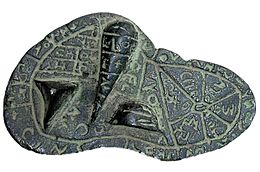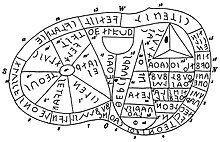Haruspex
| Part of a series on |
| Anthropology of religion |
|---|
 |
| Social and cultural anthropology |
In the religion of ancient Rome, a haruspex (plural haruspices; also called aruspex) was a person trained to practise a form of divination called haruspicy (haruspicina), the inspection of the entrails (exta—hence also extispicy (extispicium)) of sacrificed animals, especially the livers of sacrificed sheep and poultry. The reading of omens specifically from the liver is also known by the Greek term hepatoscopy (also hepatomancy).
The Roman concept is directly derived from Etruscan religion, as one of the three branches of the disciplina Etrusca. Such methods continued to be used well into the Middle Ages, especially among Christian apostates and pagans, with Thomas Becket apparently consulting both a haruspex and a chiromancer prior to a royal expedition against Brittany.[1]
The Latin terms haruspex and haruspicina are from an archaic word, haru = "entrails, intestines" (cognate with hernia = "protruding viscera" and hira = "empty gut"; PIE *ǵʰer-) and from the root spec- = "to watch, observe". The Greek ἡπατοσκοπία hēpatoskōpia is from hēpar = "liver" and skop- = "to examine".
Ancient Near East[]

The spread of hepatoscopy is one of the clearest examples of cultural contact in the orientalizing period. It must have been a case of East-West understanding on a relatively high, technical level. The mobility of migrant charismatics is the natural prerequisite for this diffusion, the international role of sought-after specialists, who were, as far as their art was concerned, nevertheless bound to their father-teachers. We cannot expect to find many archaeologically identifiable traces of such people, other than some exceptional instances.
— Walter Burkert, 1992. The Orientalizing Revolution: Near Eastern Influence on Greek Culture in the Early Archaic Age (Thames and Hudson), p. 51.
The Babylonians were famous for hepatoscopy. This practice is mentioned in the Book of Ezekiel 21:21:
For the king of Babylon standeth at the parting of the way, at the head of the two ways, to use divination; he shaketh the arrows to and fro, he inquireth of the teraphim, he looketh in the liver.[2][3]
The Nineveh library texts name more than a dozen liver-related terms. The liver was considered the source of the blood and hence the basis of life itself. From this belief, the Babylonians thought they could discover the will of the gods by examining the livers of carefully selected sheep. A priest known as a bārû was specially trained to interpret the "signs" of the liver, and Babylonian scholars assembled a monumental compendium of omens called the Bārûtu. The liver was divided into sections, with each section representing a particular deity.[citation needed]
One Babylonian clay model of a sheep's liver, dated between 1900 and 1600 BC, is conserved in the British Museum.[4] The model was used for divination, which was important to Mesopotamian medicine. This practice was conducted by priests and seers who looked for signs in the stars, or in the organs of sacrificed animals, to tell them things about a patient's illness. Wooden pegs were placed in the holes of the clay tablet to record features found in a sacrificed animal's liver. The seer then used these features to predict the course of a patient's illness.[citation needed]
Haruspicy was part of a larger study of organs for the sake of divination, called extispicy, paying particular attention to the positioning of the organs and their shape. There are many records of different peoples using the liver and spleen of various domestic and wild animals to forecast weather. There are hundreds of ancient architectural objects, labyrinths composed of cobblestones in the northern countries that are considered to be a model of the intestines of the sacrificial animal, i.e. the colon of ruminants.[citation needed]
The Assyro-Babylonian tradition was also adopted in Hittite religion. At least thirty-six liver-models have been excavated at Hattusa. Of these, the majority are inscribed in Akkadian, but a few examples also have inscriptions in the native Hittite language, indicating the adoption of haruspicy as part of the native, vernacular cult.[5]
Haruspicy in Ancient Greece[]
Divination called haruspicy was also practiced in ancient Greece. Several Greek vases show images of liver divination.[citation needed]
Haruspicy in Ancient Italy[]
Roman haruspicy was a form of communication with the gods. Rather than strictly predicting future events, this form of Roman divination allowed humans to discern the attitudes of the gods and react in a way that would maintain harmony between the human and divine worlds (pax deorum).[6] Before taking important actions, especially in battle, Romans conducted animal sacrifices to discover the will of the gods according to the information gathered through reading the animals' entrails.[6] The entrails (most importantly the liver, but also the lungs and heart) contained a large number of signs that indicated the gods' approval or disapproval. These signs could be interpreted according to the appearance of the organs, for example, if the liver was "smooth, shiny and full" or "rough and shrunken".[7]


Haruspicy in Ancient Italy originated with the Etruscans. Textual evidence for Etruscan divination comes from an Etruscan inscription: the priest Laris Pulenas' (250–200 BCE) epitaph mentions a book he wrote on haruspicy. A collection of sacred texts called the Etrusca disciplina, written in Etruscan, were essentially guides on different forms of divination, including haruspicy and augury.[8] In addition, a number of archeological artifacts depict Etruscan haruspicy. These include a bronze mirror with an image of a haruspex dressed in Etruscan priest's clothing, holding a liver while a crowd gathers near him. Another significant artifact relating to haruspicy in Ancient Italy is the Piacenza Liver. This bronze model of a sheep's liver was found by chance by a farmer in 1877. Names of gods are etched into the surface and organized into different sections.[8] Artifacts depicting haruspicy exist from the ancient Roman world as well, such as stone relief carvings located in Trajan's Forum.[7]
See also[]
- Anthropomancy
- Augur
- Auspice
References[]
- ^ Thorndike, Lynn (1923). A history of magic and experimental science. 2. New York, Macmillan. p. 167.
- ^ "Ezekiel 21". Hebrew Bible in English. Mechon-Mamre.
- ^ See also: Darshan, Guy, "The Meaning of bārēʾ (Ez 21,24) and the Prophecy Concerning Nebuchadnezzar at the Crossroads (Ez 21,23-29)", ZAW 128 (2016), 83-95.
- ^ The Liver tablet 92668.
- ^ four specimens are known to Güterbock (1987): CTH 547 II, KBo 9 67, KBo 25, KUB 4 72 (VAT 8320 in Vorderasiatisches Museum Berlin), for which see also George Sarton, Ancient Science Through the Golden Age of Greece (1952, 1970), p. 93, citing Alfred Boissier, Mantique babylonienne et mantique hittite (1935).
- ^ Jump up to: a b Johnston, Sarah Iles. "Divination: Greek and Roman Divination". In Encyclopedia of Religion, 2nd ed., edited by Lindsay Jones, 2375–2378. Vol. 4. Detroit, Michigan: Macmillan Reference USA, 2005. Gale eBooks.
- ^ Jump up to: a b Driediger-Murphy, Lindsay G, and Eidinow, Esther. Ancient Divination and Experience. Oxford: Oxford University Press USA - OSO, 2019.
- ^ Jump up to: a b MacIntosh Turfa, Jean, and Tambe, Ashwini, eds. The Etruscan World. London: Taylor & Francis Group, 2013. ProQuest Ebook Central.
Bibliography[]
- Walter Burkert, 1992. The Orientalizing Revolution: Near Eastern Influence on Greek Culture in the Early Archaic Age (Thames and Hudson), pp 46–51.
- Derek Collins, "Mapping the Entrails: The Practice of Greek Hepatoscopy" American Journal of Philology 129 [2008]: 319-345
- Marie-Laurence Haack, Les haruspices dans le monde romain (Bordeaux : Ausonius, 2003).
- Hans Gustav Güterbock, 'Hittite liver models' in: Language, Literature and History (FS Reiner) (1987), 147–153, reprinted in Hoffner (ed.) Selected Writings, Assyriological Studies no. 26 (1997).[1]
External links[]
- Chisholm, Hugh, ed. (1911). . Encyclopædia Britannica. 13 (11th ed.). Cambridge University Press. pp. 37–38. This source suggests that Greek and Roman haruspices used the entrails of human corpses; the victim should be "without spot or blemish".
- Haruspices, article in Smith's Dictionary of Greek and Roman Antiquities
- Figurine of Haruspex, 4th Cent. B.C. Vatican Museums Online, Gregorian Etruscan Museum, Room III
- l. Starr (1992). "Chapters 1 and 2 of the bārûtu". State Archives of Assyria Bulletin. 6: 45–53.
- Ancient Roman augury
- Divination
- Etruscan religion
- Middle Eastern mythology
- Ancient Roman occupations

